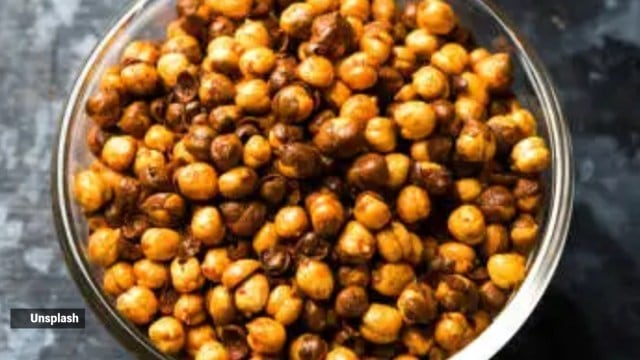📣 For more lifestyle news, click here to join our WhatsApp Channel and also follow us on Instagram
Why dietitians want you to be cautious when consuming ‘protein-rich’ roasted chickpeas
To stay safe, always check labels carefully before purchasing packaged roasted chickpeas
 Do you have roasted chickpeas? (Photo: Unsplash)
Do you have roasted chickpeas? (Photo: Unsplash)Roasted chickpeas (chana) are often promoted as a healthy, protein-rich snack. However, not all packaged or commercially roasted chickpeas are as wholesome as they appear. “Some may contain chemical residues or additives that can affect your health if consumed regularly,” said Dt. Deepali Sharma, clinical nutritionist, CK Birla Hospital, Delhi.
One concern is the possible presence of acrylamide, a chemical compound that forms naturally when starchy foods are roasted or fried at high temperatures.
Notably, acrylamide forms as a byproduct of the Maillard Reaction, which is the chemical process responsible for the desirable golden-brown colour, flavour, and aroma of roasted foods. “The main precursors are the naturally occurring amino acid Asparagine and reducing sugars (like glucose and fructose) found in plant-based foods, including chickpeas. The hotter and longer the roasting time, the more these precursors react to form acrylamide,” said Dr Archana Batra, dietitian and certified diabetes educator.
According to Dr Batra, acrylamide has been linked to potential neurotoxic and carcinogenic effects in long-term studies. Dr Batra said acrylamide is classified by the International Agency for Research on Cancer (IARC) as a probable human carcinogen (Group 2A) based on studies in laboratory animals. “In the body, acrylamide is converted into glycidamide, which can potentially cause genetic damage. While human epidemiological studies have not consistently shown a strong link between dietary acrylamide and cancer risk at normal consumption levels, regulatory bodies like the FDA and WHO advise reducing intake to ‘as low as reasonably achievable’ (ALARA) due to its potential long-term risks,” explained Dr Batra.
Additionally, some low-quality or artificially flavoured roasted chickpeas may contain preservatives (such as sodium benzoate), artificial colours, or flavour enhancers (such as MSG), which can irritate the digestive system or cause allergic reactions in sensitive individuals, Sharma contended.
 Here’s what you should know (Photo: Getty Images/Thinkstock)
Here’s what you should know (Photo: Getty Images/Thinkstock)
To stay safe, always check labels carefully before purchasing packaged roasted chickpeas. Prefer products labelled as “roasted at low temperature”, “no preservatives”, or “100 per cent natural ingredients.” “If buying loose roasted chana, ensure it’s from a hygienic source and doesn’t have a burnt or chemical-like smell,” said Sharma.
For the healthiest option, roast chickpeas at home using a pan or oven. “Homemade roasting helps you control both the temperature and the ingredients, ensuring your snack remains natural, nutritious, and chemical-free,” shared Sharma.
To enjoy roasted chickpeas while minimising your exposure, focus on reducing the temperature and duration of the cooking process:
Go for Gold’: The most crucial rule is to roast the chickpeas to a golden yellow colour or lighter, rather than a dark brown or crispy, burnt shade. Darker browning indicates higher acrylamide formation, said Dr Batra.
Lower temperature, longer time: When roasting at home, use a slightly lower temperature and extend the cooking time if necessary, rather than blasting them at very high heat, noted Dr Batra.
Soak and rinse: Soaking and thoroughly rinsing raw chickpeas before cooking may help wash away some of the surface-level sugars, thereby potentially reducing the precursors.
Balanced diet: The overall risk is related to total dietary intake. “Continue to eat a healthy, varied, and balanced diet rich in unheated foods like fresh fruits and vegetables, so that roasted chickpeas are only a small part of your overall consumption,” said Dr Batra.
DISCLAIMER: This article is based on information from the public domain and/or the experts we spoke to. Always consult your health practitioner before starting any routine.
📣 For more lifestyle news, click here to join our WhatsApp Channel and also follow us on Instagram



- 01
- 02
- 03
- 04
- 05
























